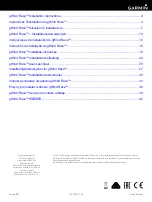Rev. 1.0
149
Si4010-C2
On this device the GPIO[5] is shared with the LED current driver, which can drive up to 1mA of current to
the ground. Normally the LED will be connected in between the GPIO[5] and VDD. For C2 to work the LED
driver is disabled during debugging sessions, so even if the user code tries to turn the LED on, that opera-
tion will not interfere with C2 debug transactions and the actual LED current driver will not be turned on.
Whenever the user disconnects the IDE from the device by hitting the
Disconnect
button on the IDE, the
IDE clears all the breakpoints, clears the LED driver disable (enables the LED), and runs the currently
loaded user application residing in the CODE/XDATA RAM from the current position where the code was
halted. If IDE is disconnected from the device the user application behaves exactly as programmed, with
the LED driver driving the LED per user application. The user then can connect to the device through IDE
by hitting the
Connect
button. The connection is only possible when the LED driver is not active. Upon
connection the IDE will disable the LED driver for the duration of the debug session (until the device is
Disconnect
-ed).
The GPIO[4] can be used as a bidirectional input/output by a user application, but a resistive network has
to be used to isolate the GPIO[4] from the C2 transactions, as shown in Figure 35.1.
Instead of the USB debug adapter the user can also use Silicon Labs ToolStick development tool. The
ToolStick has a PCB edge 14 pin connector. Connection in between the device and the ToolStick for soft-
ware development and debugging is in Figure 35.2.


















